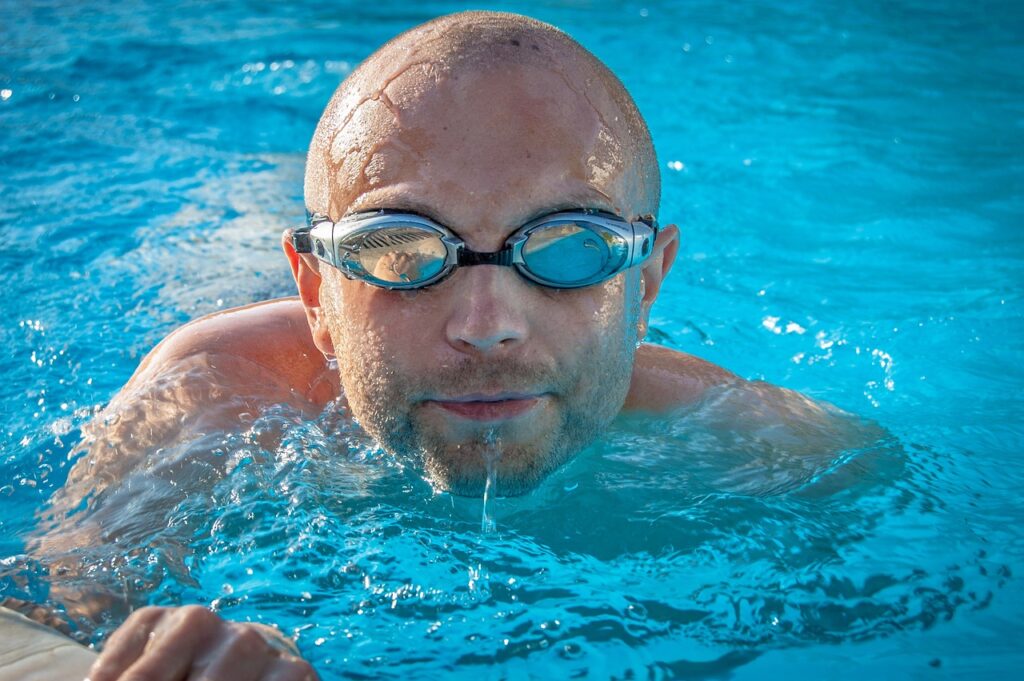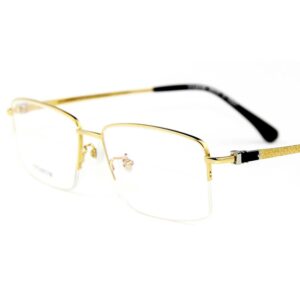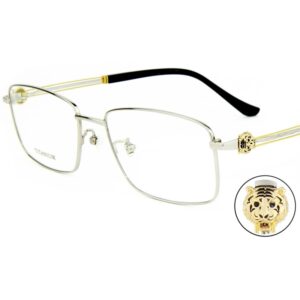Injection molding has become a cornerstone in the manufacturing of eyewear. This technique has revolutionized the way glasses are produced, allowing for rapid, consistent, and versatile production of a wide array of eyewear types. Whether it’s sports eyewear that needs to be tough and resilient, or stylish sunglasses that offer protection and aesthetic appeal, injection molding makes it possible to meet these diverse needs efficiently. This process is celebrated for its ability to mass-produce eyewear with high precision and minimal waste, making it a preferred choice in the industry. In this article, we’ll explore how injection molding works, the different types of eyewear that benefit from this process, and why it’s so widely used in the industry.
Overview of Injection Molding
How It Works:
Injection molding is a manufacturing process where molten plastic material is injected into a mold, cooled, and then ejected as a solidified part. The process is highly automated, ensuring that each product is made to exact specifications with minimal human error. The materials used in injection molding for eyewear typically include various plastics like TR90, nylon, polycarbonate, and bio-based polymers.
The process can be broken down into the following steps:
- Melting the Material: Plastic pellets are fed into a machine where they are heated until they become molten.
- Injecting the Material: The molten plastic is then injected into a mold cavity under high pressure.
- Cooling: The plastic cools and hardens inside the mold, taking the shape of the mold cavity.
- Ejection: Once cooled, the mold opens, and the finished part is ejected.
Advantages:
- High Efficiency: Once the mold is created, production can be extremely fast, allowing for high volumes of eyewear to be produced quickly.
- Consistency: Each piece produced is identical, ensuring a consistent level of quality across the entire production run.
- Material Versatility: Injection molding supports a wide range of materials, allowing manufacturers to tailor their products to specific needs—be it durability, flexibility, or cost-efficiency.
Below, we’ll dive into the specific types of eyewear that are commonly made using injection molding.
Types of Eyewear Made with Injection Molding
1. Sports Eyewear
| Materials | Characteristics | Advantages |
| TR90, Nylon, Polycarbonate | High impact resistance, lightweight, flexible | Protects eyes during sports, durable, comfortable to wear for long periods |

Sports eyewear is designed to withstand the rigors of physical activity. Injection molding allows for the use of materials like TR90 and nylon, which are both flexible and durable. These glasses can absorb impact, reducing the likelihood of breakage, and they are lightweight, ensuring comfort during prolonged use. This makes them ideal for athletes and outdoor enthusiasts.
-

Bulk Buy TR90 Optical Frames – 2223
$50.00 Select options This product has multiple variants. The options may be chosen on the product page -
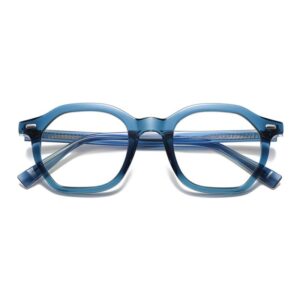
Bulk Wholesale TR90 Optical Frames – 2095
$50.00 Select options This product has multiple variants. The options may be chosen on the product page -

Bulk Wholesale TR90 Optical Frames Supplier – KY58092
$50.00 Select options This product has multiple variants. The options may be chosen on the product page -

Buy Fashion TR90 Eyewear in Bulk – 8600
$50.00 Select options This product has multiple variants. The options may be chosen on the product page
2. Sunglasses
| Materials | Characteristics | Advantages |
| Polycarbonate, Copolyester, Acetate | UV protection, stylish, lightweight | Protects eyes from UV rays, offers stylish designs, comfortable |

Sunglasses are not just a fashion statement—they are essential for protecting your eyes from harmful UV rays. Polycarbonate is often used for the lenses due to its excellent UV protection and lightweight nature. The frames are usually made from materials like copolyester or acetate, which can be molded into a variety of stylish designs. Injection molding allows for precise and consistent production, ensuring that each pair offers the same high level of protection and style.
-

Bulk Wholesale TR90 Sunglasses Supplier – LY2145
$50.00 Select options This product has multiple variants. The options may be chosen on the product page -
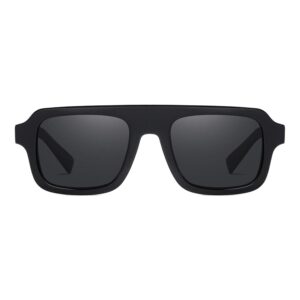
Buy Wholesale Acetate Sunglasses in Bulk – S32101
$90.00 Select options This product has multiple variants. The options may be chosen on the product page -

Wholesale Acetate Sunglasses Distributor – 882218S
$90.00 Select options This product has multiple variants. The options may be chosen on the product page -

Wholesale TR90 Sunglasses – BL7043
$50.00 Select options This product has multiple variants. The options may be chosen on the product page
3. Children’s Eyewear
| Materials | Characteristics | Advantages |
| Thermoplastic Elastomers (TPE), Thermoplastic Polyurethane (TPU) | Soft, durable, safe | Withstands rough handling, comfortable, child-safe |

Children’s eyewear needs to be tough, safe, and comfortable. Injection molding with materials like TPE and TPU results in glasses that are both soft and flexible, which is perfect for kids who might drop or mishandle their eyewear. These materials also make the glasses comfortable to wear, reducing the chances of irritation.
-

China Customized Kids Glasses Manufacturers Suppliers – JH-TR207
$50.00 Select options This product has multiple variants. The options may be chosen on the product page -

China Wholesale Kids Optical Eyeglasses Frame – JH-TR206
$50.00 Select options This product has multiple variants. The options may be chosen on the product page -
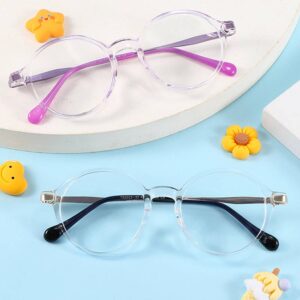
Wholesale Kids Eyeglasses Frames – JH2023-32
$50.00 Select options This product has multiple variants. The options may be chosen on the product page -

Wholesale Kids Optical Glasses – JH2023-27
$50.00 Select options This product has multiple variants. The options may be chosen on the product page
4. Safety Glasses
| Materials | Characteristics | Advantages |
| Polycarbonate, ABS | High impact resistance, protective, durable | Protects eyes in hazardous environments, withstands heavy use |

5. Fast Fashion Eyewear
Safety glasses need to offer reliable protection in hazardous environments, such as industrial sites or laboratories. Injection molding allows for the use of polycarbonate and ABS, materials known for their durability and impact resistance. This ensures that the glasses can protect the wearer from flying debris, chemicals, and other dangers.
| Materials | Characteristics | Advantages |
| Polypropylene, ABS | Cost-effective, trendy designs, mass-produced | Meets fast-changing fashion trends, affordable, easy to produce in large quantities |

Fast fashion eyewear is all about keeping up with the latest trends without breaking the bank. Injection molding is perfect for this market because it can produce large quantities of trendy glasses quickly and at a low cost. Materials like polypropylene and ABS are often used because they are inexpensive and easy to mold into the latest styles.
6. Blue Light Blocking Glasses
| Materials | Characteristics | Advantages |
| Copolyester, TR90 | Blocks blue light, lightweight, comfortable | Reduces eye strain, prevents sleep disturbances, suitable for long-term wear |
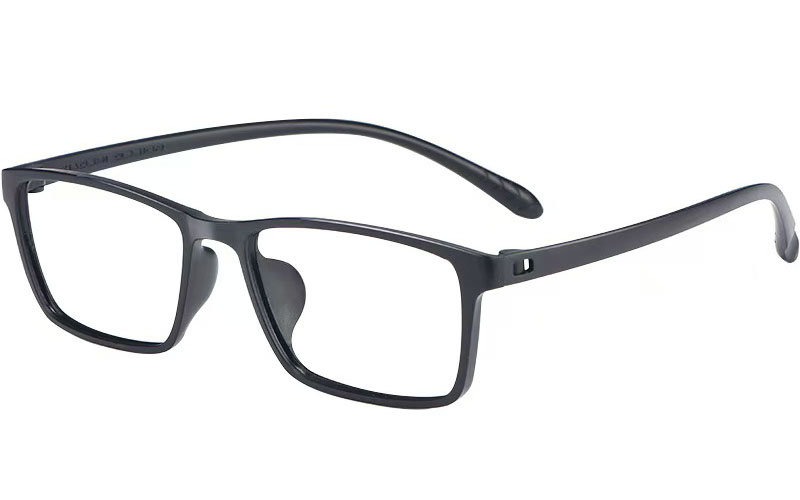
As more people spend time in front of screens, blue light blocking glasses have become increasingly popular. Injection molding allows manufacturers to produce lightweight, comfortable frames using materials like copolyester and TR90. These glasses are designed to filter out harmful blue light, reducing eye strain and helping prevent sleep disturbances.
7. Reading Glasses
| Materials | Characteristics | Advantages |
| Cellulose Acetate, Copolyester | Stylish, durable, available in various strengths | Offers a range of magnifications, stylish designs, durable for daily use |

Reading glasses are another eyewear category where injection molding is commonly used. The process allows for the production of durable, stylish frames that can hold up to daily use. Cellulose acetate is a popular choice for its high-quality feel and design versatility, while copolyester offers a more budget-friendly option. Injection molding ensures that these glasses can be produced in a wide range of strengths to meet the varying needs of consumers.
8. Fashion Eyewear
| Materials | Characteristics | Advantages |
| Cellulose Acetate, TR90 | Trendy, customizable, available in various colors and patterns | Allows for intricate designs, offers a wide range of styles, customizable for different preferences |

Fashion eyewear is all about making a statement. Injection molding enables manufacturers to produce frames that are not only functional but also fashionable. Materials like cellulose acetate are favored for their rich colors and luxurious feel, while TR90 offers a more affordable but equally stylish alternative. With injection molding, intricate designs and patterns can be created, ensuring that fashion-conscious consumers can find eyewear that truly reflects their personal style.
9. Industrial Protective Eyewear
| Materials | Characteristics | Advantages |
| Nylon, Polycarbonate | High durability, resistant to harsh environments, protective | Withstands tough conditions, provides eye protection in industrial settings |

For those working in tough environments, industrial protective eyewear is a must. Injection molding allows for the creation of frames and lenses that are both strong and resilient. Nylon and polycarbonate are the materials of choice here, offering excellent chemical resistance, durability, and impact protection. These features ensure that the eyewear can withstand the demands of industrial settings while keeping the wearer safe.
Receive Custom Guidance
Looking for the perfect custom eyewear to represent your brand?
Reach out to Eyewearbeyond for expert guidance on choosing the best materials, styles, and customizations for your eyewear collection!
Other Injection-Molded Eyewear Components
| Component | Materials | Function |
| Frames | Varies (TR90, nylon, polycarbonate, etc.) | Provides structural support, determines the fit and comfort of the eyewear |
| Nose Pads | TPU, Silicone | Enhances comfort, improves fit, prevents slipping |
| Temples | TR90, TPE | Provides flexibility, adjustable fit, ensures stability on the wearer’s face |
Frames: Frames are the backbone of any pair of glasses, and injection molding is the perfect technique for making them. The material used can vary depending on the type of eyewear, but the process ensures that each frame is consistent in size, shape, and quality. Whether it’s a lightweight frame for sports glasses or a more robust frame for safety glasses, injection molding can handle it all.
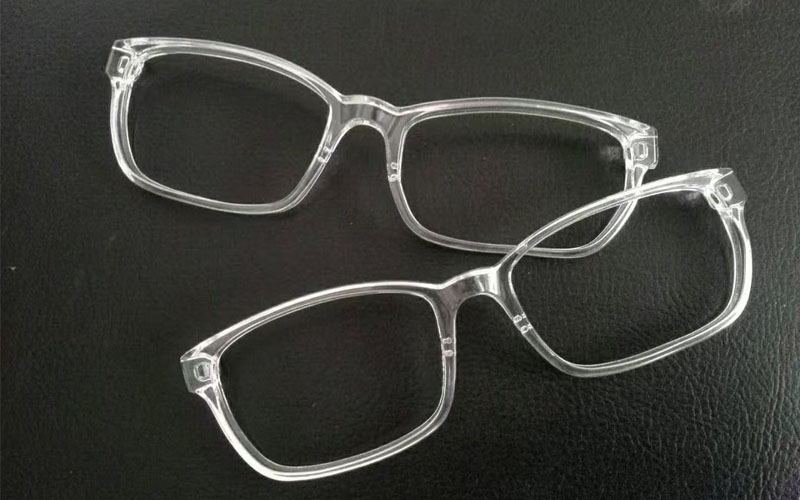
Nose Pads: Though small, nose pads play a big role in the overall comfort of the eyewear. Injection molding allows manufacturers to produce soft, flexible nose pads from materials like TPU and silicone. These pads cushion the bridge of the nose and help prevent the glasses from slipping, enhancing the overall wearability of the eyewear.

Temples (Arms): The temples, or arms, of the glasses, are another critical component that benefits from injection molding. Materials like TR90 and TPE are chosen for their flexibility and durability, allowing the temples to bend without breaking and providing a snug, comfortable fit. Injection molding ensures that these parts are produced to exact specifications, contributing to the overall comfort and stability of the eyewear.

Conclusion
Injection molding is a versatile and highly efficient manufacturing method that has revolutionized the eyewear industry. Its ability to produce a wide range of eyewear types—from rugged sports glasses to trendy fashion frames—makes…it an invaluable tool for manufacturers. By choosing the right materials and applying precise molding techniques, manufacturers can produce eyewear that meets the specific needs of different consumers—whether they prioritize style, protection, or comfort. Injection molding’s role in eyewear production is crucial, allowing manufacturers to cater to varying market demands with high efficiency and consistent quality. As the eyewear industry continues to evolve, injection molding will undoubtedly remain at the forefront of innovation, shaping the future of high-quality, diverse eyewear.
In conclusion, injection molding is a cornerstone in modern eyewear manufacturing. It offers the perfect blend of efficiency, versatility, and quality, making it the go-to method for producing everything from sports eyewear to fashionable sunglasses. By leveraging the strengths of various materials and precise molding processes, manufacturers can create products that not only meet but exceed consumer expectations, ensuring that injection molding will continue to play a vital role in the eyewear industry for years to come.
FAQ: Eyewear Types Made with Injection Molding
1. What is injection molding, and why is it used in eyewear production?
Injection molding is a manufacturing process where molten material, usually plastic, is injected into a mold to form specific shapes. It’s widely used in eyewear production because it allows for the efficient mass production of high-quality, consistent products. The process is highly precise, reducing waste and making it possible to create complex designs quickly and affordably.
2. Which types of eyewear are commonly made using injection molding?
Several types of eyewear are made using injection molding, including:
- Sports Eyewear: Known for its durability and impact resistance, made from materials like TR90 and nylon.
- Sunglasses: Lightweight and protective, often made from polycarbonate and copolyester.
- Children’s Eyewear: Soft and safe, typically using thermoplastic elastomers (TPE) and thermoplastic polyurethane (TPU).
- Safety Glasses: Highly durable and protective, crafted from polycarbonate and ABS.
- Fast Fashion Eyewear: Trendy and cost-effective, often made from polypropylene and ABS.
3. What are the benefits of using injection molding in eyewear manufacturing?
Injection molding offers several key benefits:
- Efficiency: High-volume production is possible with minimal waste.
- Consistency: Every piece produced is identical, ensuring uniform quality.
- Versatility: It supports a wide range of materials, allowing for diverse product lines.
- Precision: The process can create complex shapes and intricate designs with high accuracy.
4. What materials are typically used in injection-molded eyewear?
Common materials include:
- TR90: Lightweight, flexible, and durable, ideal for sports and casual eyewear.
- Polycarbonate: High impact resistance and UV protection, commonly used in sunglasses and safety glasses.
- Nylon: Strong and durable, often used in industrial and protective eyewear.
- ABS: Rigid and lightweight, frequently used in fast fashion and budget eyewear.
- Cellulose Acetate: Rich in color and luxurious, used in fashion and reading glasses.
5. How does injection molding benefit the production of children’s eyewear?
Injection molding is perfect for children’s eyewear because it allows for the creation of soft, flexible frames that can withstand rough handling. Materials like TPE and TPU are used to ensure the glasses are both comfortable and durable, making them safe for children to wear.
6. Are injection-molded glasses more durable than other types?
Yes, injection-molded glasses tend to be more durable due to the strength of the materials used, such as TR90, polycarbonate, and nylon. These materials are chosen for their ability to withstand impacts, resist wear and tear, and maintain their shape over time.
7. Can injection molding be used for custom or designer eyewear?
Absolutely. Injection molding is not just for mass production; it also allows for the creation of intricate and customized designs. Materials like cellulose acetate and copolyester can be molded into unique shapes and patterns, making it ideal for designer and fashion eyewear.
8. What is the environmental impact of injection molding in eyewear production?
While traditional plastics used in injection molding can have environmental impacts, the industry is increasingly turning to eco-friendly materials like recycled plastics and bio-based polymers. These materials help reduce the carbon footprint of production and support sustainable practices.
9. How does injection molding compare to other manufacturing methods in eyewear production?
Injection molding is generally faster, more precise, and cost-effective compared to other methods like manual assembly or 3D printing. It’s especially advantageous for producing large quantities of eyewear with consistent quality, making it the preferred method for many manufacturers.
10. What are some of the latest trends in injection-molded eyewear?
Recent trends include the use of more sustainable materials, such as bio-based polymers and recycled plastics, as well as the integration of smart technology in eyewear. There’s also a growing focus on customizing eyewear for specific needs, such as blue light blocking glasses and ergonomically designed frames.
Request a Free Quote
Wondering how to budget for your custom eyewear order?
Contact us to receive a tailored quote designed specifically for your eyewear needs!

